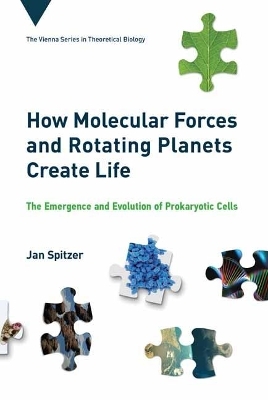
How Molecular Forces and Rotating Planets Create Life
The Emergence and Evolution of Prokaryotic Cells
Seiten
2021
MIT Press (Verlag)
978-0-262-04557-5 (ISBN)
MIT Press (Verlag)
978-0-262-04557-5 (ISBN)
"An original physicochemical contribution to the problem of understanding life and its emergence, incorporating concepts from planetary sciences, chemistry and biology"--
A reconceptualization of origins research that exploits a modern understanding of non-covalent molecular forces that stabilize living prokaryotic cells. Scientific research into the origins of life remains exploratory and speculative. Science has no definitive answer to the biggest questions--What is life? and How did life begin on earth? In this book, Jan Spitzer reconceptualizes origins research by exploiting a modern understanding of non-covalent molecular forces and covalent bond formation--a physicochemical approach propounded originally by Linus Pauling and Max Delbruck. Spitzer develops the Pauling-Delbruck premise as a physicochemical jigsaw puzzle that identifies key stages in life's emergence, from the formation of first oceans, tidal sediments, and proto-biofilms to progenotes, proto-cells and the first cellular organisms.
A reconceptualization of origins research that exploits a modern understanding of non-covalent molecular forces that stabilize living prokaryotic cells. Scientific research into the origins of life remains exploratory and speculative. Science has no definitive answer to the biggest questions--What is life? and How did life begin on earth? In this book, Jan Spitzer reconceptualizes origins research by exploiting a modern understanding of non-covalent molecular forces and covalent bond formation--a physicochemical approach propounded originally by Linus Pauling and Max Delbruck. Spitzer develops the Pauling-Delbruck premise as a physicochemical jigsaw puzzle that identifies key stages in life's emergence, from the formation of first oceans, tidal sediments, and proto-biofilms to progenotes, proto-cells and the first cellular organisms.
Jan Spitzer, a PhD in Physical Chemistry from Queen Elizabeth College at the University of London, has had a long career in chemistry and polymer science, as Associate Professor, and Research and Development Manager in synthetic latex industry. He is the author or coauthor of numerous peer-reviewed papers, technical articles, and book chapters.
| Erscheinungsdatum | 08.02.2021 |
|---|---|
| Reihe/Serie | Vienna Series in Theoretical B |
| Zusatzinfo | 21 black and white illustrations |
| Sprache | englisch |
| Maße | 152 x 229 mm |
| Themenwelt | Naturwissenschaften ► Biologie ► Allgemeines / Lexika |
| ISBN-10 | 0-262-04557-5 / 0262045575 |
| ISBN-13 | 978-0-262-04557-5 / 9780262045575 |
| Zustand | Neuware |
| Haben Sie eine Frage zum Produkt? |
Mehr entdecken
aus dem Bereich
aus dem Bereich
Über hybride Mineralien, Tiere, Pflanzen, Pilze ...
Buch | Hardcover (2023)
Matthes & Seitz (Verlag)
CHF 39,20
Band 2: Elektrizität, Optik und Wellen
Buch | Softcover (2022)
Wiley-VCH (Verlag)
CHF 55,85
Berufsbilder von und für Biologen und Biowissenschaftler
Buch | Softcover (2024)
Verband Biologie, Biowiss. u. Biomedizin in Dtl. e.V. (Verlag)
CHF 23,50


